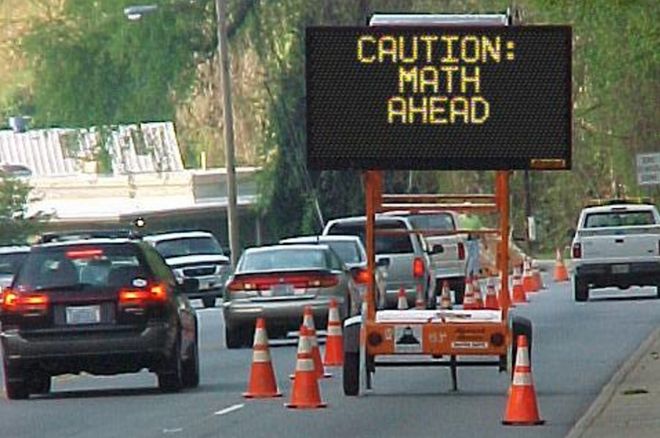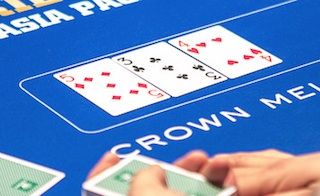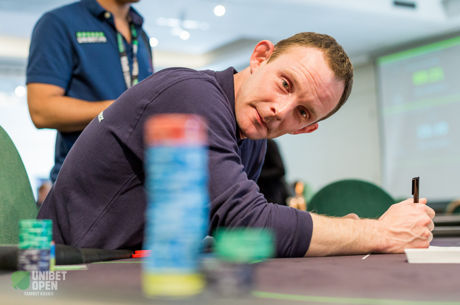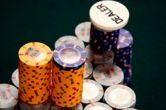How to Take Your Poker Math Beyond Counting Outs, Part 1

Most poker players who get past being rank novices soon learn how to count their outs, and memorize a few frequently encountered probabilities. However, most still remain stymied when faced with more complex poker math situations, or ones that can��t easily be looked up in a book or online.
Heck, I have on my shelf a whole book filled with tables of poker probabilities (Texas Hold��Em Odds and Probabilities by Matthew Hilger �� a really useful resource), but at least a few times a year I still come across poker probability questions that I can��t look up there or anywhere else.
The general technique to address more complicated poker probability problems is simple and straightforward, but it involves doing something that doesn��t come natural to anybody: working with combinations of cards. My goal in this two-part article is to introduce you to how this works, starting with simple and familiar cases, and working up to more complex ones.
In each example, we��ll perform the same three fundamental steps:
- Step 1. Count the total number of possible outcomes.
- Step 2. Count the number of outcomes of the kind we��re interested in.
- Step 3. Divide the latter by the former to arrive at a probability.
But first I need to familiarize you with a powerful tool �� the combinations calculator.
Using the Combinations Calculator
Suppose you wanted to know how many different combinations of numbers might be picked in a lottery. Let��s imagine that this lottery uses one of those ping-pong ball machines, with 60 numbered balls, of which five will be chosen at random as the winning combination of numbers.
The actual math is straightforward but extremely tedious to work out by hand. But there��s a much easier way to go about it �� spreadsheets have a built-in function for performing exactly this kind of computation. In Microsoft Excel, you type into any cell
=COMBIN(x,y)
where x is the number of possible objects to draw from, and y is the number to be drawn. For our hypothetical lottery, you would enter 60 and 5, respectively. Hit return or enter, and the spreadsheet spits out the answer: 5,461,512.
If you don��t have immediate access to a spreadsheet, you can find many online combination calculators that do the same thing (for example, this one). We will be using this tool in all of the examples that follow, because learning how to apply it to poker problems is the entire point of this article.
Example 1: Flush draw
You have A?K?. The flop is 2?6?10?. What is the probability that you will have a flush by the time the board is complete?
Most players soon learn the following way of thinking about it. There are nine hearts left somewhere among the 47 still-unseen cards. The probability of the turn card being a heart, then, is 9/47, or about 19%. Double that because the river card gives you a second shot at it, and you��re around 38%. Rounding that off to 40% is easily close enough for the practical purpose of making a decision at the poker table.
Though it won��t do better while in the middle of a hand, it��s useful to know how to make the calculation more precisely, because it��s the same basic process we��ll use later for harder problems. The key is this �� rather than treat fourth and fifth streets as separate events, we��ll consider them together, as pairs of cards.
How many different combinations of turn and river cards are there? For the question as it was posed, we don��t care in what order they come; the Q? followed by the 7? is just as good as the 7? followed by the Q?.
You could, with some work, count up all of the possible two-card combinations that could be drawn from 47 unknown cards. But life is short �� let��s use technology to do it for us.
I go to my spreadsheet and type in
=COMBIN(47,2)I hit ��enter,�� and Excel instantly displays 1,081. That is the number of different combinations of two cards that can be drawn from a pile of 47.
So that��s Step 1 �� the total number of possible outcomes.
Step 2 is determining how many of those pairs are the kind that we are interested in �� namely, those that include at least one heart. Because there are nine hearts left among the unseen cards, the number of pairs that we could pick that would both be hearts is given by COMBIN(9,2), which is 36. The number of different pairs with exactly one heart is given by 9 x 38 = 342, because each of the nine hearts can be paired with each of the 38 non-hearts. Therefore, the number of different pairs of cards, containing at least one heart, that one could draw from the unseen cards is 36 + 342 = 378.
Step 3 then is the easiest one. We divide the 378 from Step 2 by the 1,081 from Step 1, and get 0.350, or 35.0%.
Of course that��s pretty close to our original quick-and-dirty estimate. However, this method is much more powerful, not so much for this particular question, but because of how it can be applied to poker math problems that are unsolvable by the kind of rapid mental estimates that can be done while in the middle of a hand.
Example 2: Suited flops
Suppose you want to know, just for the sake of your general fund of poker knowledge, the relative frequencies of flops that are ��rainbow�� (i.e., three different suits), two-suited, or one-suited. This is something you could look up online if you wanted to, but I��d like you to be able to do the math yourself �� not only because you��ll remember the answer better if you work it out than if you just look it up, but because the same methodology can be applied to other questions that you can��t look up anywhere.
Step 1: As before, we need to calculate the total number of possible outcomes �� in this case, the total number of flops. Now, we could do this two ways, either taking into consideration the two cards we have been dealt in a specific hand, or ignoring them and looking at it as a more general question. I think the latter is more useful, though the two answers will be very close to each other.
So we need to know how many three-card combinations can be drawn from a deck of 52 cards.
The formula in Excel is
=COMBIN(52,3)
Or in an online combinations calculator, you enter 52 as ��n�� and 3 as ��r.�� The answer is 22,100. That is, there can be exactly 22,100 different flops in games such as hold��em and Omaha. This calculation treats all orders of any three-card combination as being equal and interchangeable. After all, we don��t really care if the dealer rearranges the three cards on the table after dealing them out.
Step 2 is counting the number of outcomes of a given type that we��re interested in. Let��s start with the easiest one �� flops of all one suit.

We��ll take spades as an example. How many different combinations of three spades are there? Back at our combinations calculator, we plug in 13 (the total number of spades) and 3 (the number we��re picking at a time), and discover that there are 286 different combinations of three spades that could make up a flop. With four suits, we have a total of 286 x 4 = 1,144 different one-suited flops.
Step 3 requires us to divide that answer by the total number of possible flops �� which we previously noted to be 22,100 �� to get a final answer of 0.052, or 5.2%. That is, just over 5% of all flops will be ��monochrome.�� That��s one part of our answer.
Next we have to repeat those steps to figure out the likelihood of a rainbow flop �� three different suits. This is trickier, and it��s actually easier to think of this one in terms of probabilities than combinations.
Suppose the first card of the flop is a club. What is the probability that the next card is something other than a club? There are 51 cards left unseen, of which 12 are clubs and 39 are non-clubs, so the probability is 39/51. For the third flop card, we now have 50 cards left, of which 12 are clubs, and 12 are whatever the suit of the second card was, leaving 26 that can complete our rainbow flop. The probability of that third card being a third suit, then, is 26/50. Thus the combined probability that both the second and third cards of the flop will be of suits different from the first, and different from each other, is 39/51 x 26/50, which is 0.398. Let��s round that to a nice, even 40%.
Now we have to determine the number of flops that have two cards of one suit and one of another. There are COMBIN(13,2) = 78 different pairs of cards that can be drawn from any one suit, say, diamonds. Then we have left 13 cards in each of the other three suits that can be the third card in our flop, making 39 in all. So that��s 78 x 39 = 3,042 different flops with two diamonds and one non-diamond. Multiply that by 4, because of four suits, and we get 12,168. Step 3 tells us to divide that by the total number of possible flops (22,100), for a final answer of 0.551, or 55%.
But if you��re attentive enough, you could have bypassed that last paragraph by simple logic. Flops must have one, two, or three suits. We had already worked out the probability of one-suited flops (5%) and of three-suited flops (40%), so all the rest �� 55% �� must be two-suited.
So there��s your worth-remembering conclusion: Over your poker career, the flops you see will be about 5% single-suited, 55% two-suited, and 40% rainbow.
Next time, we��ll raise the stakes in this game, and tackle some harder problems using the same basic steps and tools.
Image: ��AtomSmasher.�� [URL="https://creativecommons.org/licenses/by-sa/3.0/" target="_blank"]Creative Commons Attributions Share-Alike 3.0 Unported/URL].
Robert Woolley lives in Asheville, NC. He spent several years in Las Vegas and chronicled his life in poker on the ��Poker Grump�� blog.
Want to stay atop all the latest in the poker world? If so, make sure to get PokerNews updates on your social media outlets. Follow us on Twitter and find us on both Facebook and Google+!









